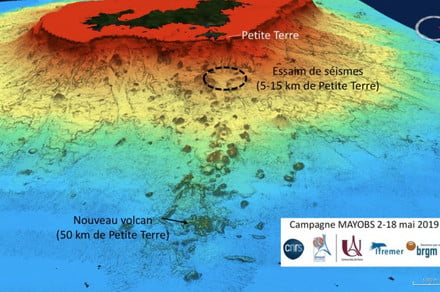An active volcano discovered 3.5km (2 miles) below the sea surface CNRS/IPGP/IFREMER/BRGM
Geologists first noticed something unusual in the Indian Ocean in November last year, when they detected a massive seismic event originating from a spot near to the French island of Mayotte. Now further research has revealed that the source of the seismic activity is an enormous underwater volcano.
The people living on Mayotte, located between Madagascar and Mozambique off the coast of Africa, had been worried by seismic tremors for months. They were experiencing small earthquakes daily, Laure Fallou, a sociologist with the European-Mediterranean Seismological Centre in Bruyères-le-Châtel, France, told Science. People “needed information,” she said. “They were getting very stressed, and were losing sleep.”
Maps of the seafloor showed a dramatic and recent change: a structure 800 meters high and 5 kilometers (3 miles) across had appeared on the ocean floor where there had been nothing before. A research team from the French National Center for Scientific Research (CNRS) were dispatched to investigate and placed six seismometers near the area of activity on the ocean floor, 3.5 kilometers (2 miles) beneath the surface.
The data the researchers collected showed there was a cluster of earthquake activity occurring beneath the Earth’s surface. And this activity is having a direct effect on the island: Mayotte has sunk 13 centimeters into the sea and has shifted 10 centimeters to the east.
The researchers believe the activity is the result of a deep magma chamber beneath the ocean floor, which erupted and pushed molten rock up onto the sea floor. As much as 5 cubic kilometers (1.2 cubic miles) of magma rose up out of the chamber and formed the structure found in the maps. As the magma rose, the chamber it came from shrunk, which caused cracks in the surrounding crust.
The formation of this particular underwater volcano is unusual as they typically form along ridges, where two or more tectonic plates meet, or they form in chains along areas where magma rises and is pulled along by tectonic forces. But the new volcano stands alone and formed very quickly.
For now, the researchers think that the volcano is not large enough to create a tsunami threat to the island. But they are concerned about the effects that repeated earthquakes could have on the stability of the ground that the island rests on. The team will be performing chemical analysis of the sea water in the area to learn more about the composition of the magma and the future risks it could pose.
Editors’ Recommendations
- The biggest bridges in the world
- The moon is shrinking as it loses heat, new images reveal
- Mercury’s wobble as it spins reveals that it has an inner solid core
- As oceans rise, one company is building cities that can swim
- Fortnite season 8 new map locations guide: Lazy Lagoon, Sunny Steps, and more

